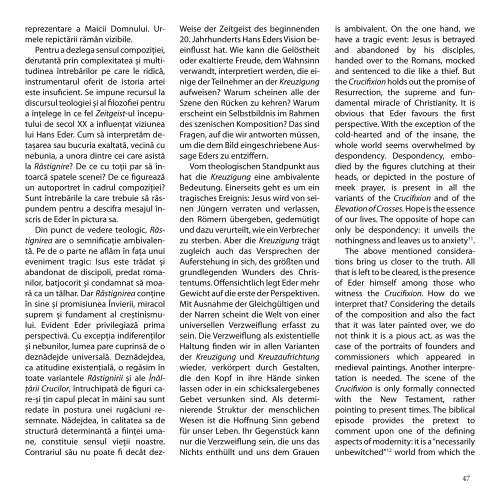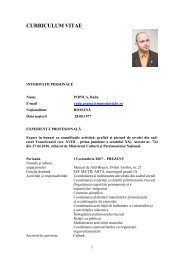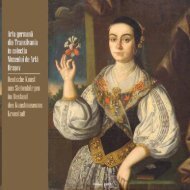Catalog Hans Eder PDF - Muzeul de Arta Brasov
Catalog Hans Eder PDF - Muzeul de Arta Brasov
Catalog Hans Eder PDF - Muzeul de Arta Brasov
Sie wollen auch ein ePaper? Erhöhen Sie die Reichweite Ihrer Titel.
YUMPU macht aus Druck-PDFs automatisch weboptimierte ePaper, die Google liebt.
eprezentare a Maicii Domnului. Urmele<br />
repictării rămân vizibile.<br />
pentru a <strong>de</strong>zlega sensul compoziţiei,<br />
<strong>de</strong>rutantă prin complexitatea şi multitudinea<br />
întrebărilor pe care le ridică,<br />
instrumentarul oferit <strong>de</strong> istoria artei<br />
este insuficient. Se impune recursul la<br />
discursul teologiei şi al filozofiei pentru<br />
a înţelege în ce fel Zeitgeist-ul începutului<br />
<strong>de</strong> secol xx a influenţat viziunea<br />
lui <strong>Hans</strong> <strong>E<strong>de</strong>r</strong>. cum să interpretăm <strong>de</strong>taşarea<br />
sau bucuria exaltată, vecină cu<br />
nebunia, a unora dintre cei care asistă<br />
la Răstignire? De ce cu toţii par să întoarcă<br />
spatele scenei? De ce figurează<br />
un autoportret în cadrul compoziţiei?<br />
Sunt întrebările la care trebuie să răspun<strong>de</strong>m<br />
pentru a <strong>de</strong>scifra mesajul înscris<br />
<strong>de</strong> <strong>E<strong>de</strong>r</strong> în pictura sa.<br />
Din punct <strong>de</strong> ve<strong>de</strong>re teologic, Răstignirea<br />
are o semnificaţie ambivalentă.<br />
pe <strong>de</strong> o parte ne aflăm în faţa unui<br />
eveniment tragic: isus este trădat şi<br />
abandonat <strong>de</strong> discipoli, predat romanilor,<br />
batjocorit şi condamnat să moară<br />
ca un tâlhar. Dar Răstignirea conţine<br />
în sine şi promisiunea Învierii, miracol<br />
suprem şi fundament al creştinismului.<br />
Evi<strong>de</strong>nt <strong>E<strong>de</strong>r</strong> privilegiază prima<br />
perspectivă. cu excepţia indiferenţilor<br />
şi nebunilor, lumea pare cuprinsă <strong>de</strong> o<br />
<strong>de</strong>znă<strong>de</strong>j<strong>de</strong> universală. Deznă<strong>de</strong>j<strong>de</strong>a,<br />
ca atitudine existenţială, o regăsim în<br />
toate variantele Răstignirii şi ale Înălţării<br />
Crucilor, întruchipată <strong>de</strong> figuri care-şi<br />
ţin capul plecat în mâini sau sunt<br />
redate în postura unei rugăciuni resemnate.<br />
Nă<strong>de</strong>j<strong>de</strong>a, în calitatea sa <strong>de</strong><br />
structură <strong>de</strong>terminantă a fiinţei umane,<br />
constituie sensul vieţii noastre.<br />
contrariul său nu poate fi <strong>de</strong>cât <strong>de</strong>z-<br />
Weise <strong>de</strong>r zeitgeist <strong>de</strong>s beginnen<strong>de</strong>n<br />
20. Jahrhun<strong>de</strong>rts <strong>Hans</strong> <strong>E<strong>de</strong>r</strong>s vision beeinflusst<br />
hat. Wie kann die Gelöstheit<br />
o<strong>de</strong>r exaltierte Freu<strong>de</strong>, <strong>de</strong>m Wahnsinn<br />
verwandt, interpretiert wer<strong>de</strong>n, die einige<br />
<strong>de</strong>r teilnehmer an <strong>de</strong>r Kreuzigung<br />
aufweisen? Warum scheinen alle <strong>de</strong>r<br />
Szene <strong>de</strong>n Rücken zu kehren? Warum<br />
erscheint ein Selbstbildnis im Rahmen<br />
<strong>de</strong>s szenischen Komposition? Das sind<br />
Fragen, auf die wir antworten müssen,<br />
um die <strong>de</strong>m Bild eingeschriebene Aussage<br />
<strong>E<strong>de</strong>r</strong>s zu entziffern.<br />
vom theologischen Standpunkt aus<br />
hat die Kreuzigung eine ambivalente<br />
Be<strong>de</strong>utung. Einerseits geht es um ein<br />
tragisches Ereignis: Jesus wird von seinen<br />
Jüngern verraten und verlassen,<br />
<strong>de</strong>n Römern übergeben, ge<strong>de</strong>mütigt<br />
und dazu verurteilt, wie ein verbrecher<br />
zu sterben. Aber die Kreuzigung trägt<br />
zugleich auch das versprechen <strong>de</strong>r<br />
Auferstehung in sich, <strong>de</strong>s größten und<br />
grundlegen<strong>de</strong>n Wun<strong>de</strong>rs <strong>de</strong>s christentums.<br />
offensichtlich legt <strong>E<strong>de</strong>r</strong> mehr<br />
Gewicht auf die erste <strong>de</strong>r perspektiven.<br />
Mit Ausnahme <strong>de</strong>r Gleichgültigen und<br />
<strong>de</strong>r Narren scheint die Welt von einer<br />
universellen verzweiflung erfasst zu<br />
sein. Die verzweiflung als existentielle<br />
Haltung fin<strong>de</strong>n wir in allen varianten<br />
<strong>de</strong>r Kreuzigung und Kreuzaufrichtung<br />
wie<strong>de</strong>r, verkörpert durch Gestalten,<br />
die <strong>de</strong>n Kopf in ihre Hän<strong>de</strong> sinken<br />
lassen o<strong>de</strong>r in ein schicksalergebenes<br />
Gebet versunken sind. Als <strong>de</strong>terminieren<strong>de</strong><br />
Struktur <strong>de</strong>r menschlichen<br />
Wesen ist die Hoffnung Sinn gebend<br />
für unser Leben. ihr Gegenstück kann<br />
nur die verzweiflung sein, die uns das<br />
Nichts enthüllt und uns <strong>de</strong>m Grauen<br />
is ambivalent. on the one hand, we<br />
have a tragic event: Jesus is betrayed<br />
and abandoned by his disciples,<br />
han<strong>de</strong>d over to the Romans, mocked<br />
and sentenced to die like a thief. But<br />
the Crucifixion holds out the promise of<br />
Resurrection, the supreme and fundamental<br />
miracle of christia nity. it is<br />
obvious that <strong>E<strong>de</strong>r</strong> favours the first<br />
perspective. With the exception of the<br />
cold-hearted and of the insane, the<br />
whole world seems overwhelmed by<br />
<strong>de</strong>spon<strong>de</strong>ncy. Despon<strong>de</strong>ncy, embodied<br />
by the figures clutching at their<br />
heads, or <strong>de</strong>picted in the posture of<br />
meek prayer, is present in all the<br />
variants of the Crucifixion and of the<br />
Elevation of Crosses. Hope is the essence<br />
of our lives. the opposite of hope can<br />
only be <strong>de</strong>spon<strong>de</strong>ncy: it unveils the<br />
nothingness and leaves us to anxiety 11 .<br />
the above mentioned consi<strong>de</strong> rations<br />
bring us closer to the truth. All<br />
that is left to be cleared, is the pre sence<br />
of <strong>E<strong>de</strong>r</strong> himself among those who<br />
witness the Crucifixion. How do we<br />
interpret that? consi<strong>de</strong>ring the <strong>de</strong>tails<br />
of the composition and also the fact<br />
that it was later painted over, we do<br />
not think it is a pious act, as was the<br />
case of the portraits of foun<strong>de</strong>rs and<br />
commissioners which appeared in<br />
medieval paintings. Another interpretation<br />
is nee<strong>de</strong>d. the scene of the<br />
Crucifixion is only formally connected<br />
with the New testament, rather<br />
pointing to present times. the biblical<br />
episo<strong>de</strong> provi<strong>de</strong>s the pretext to<br />
comment upon one of the <strong>de</strong>fining<br />
aspects of mo<strong>de</strong>rnity: it is a “necessarily<br />
unbewitched” 12 world from which the








